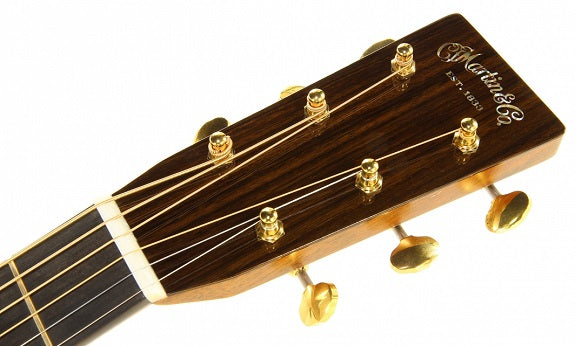Your Cart is Empty
September 17, 2020 4 min read

If you’re not familiar with Martin’s naming system, all of this business about sizes and styles may be a bit confusing to you. For example, when I say that I’d like to compare the D-18 to the OM-28, the names of the guitars tell me quite a lot before I even sit down and strum the first chord. In the Martin naming system you always have first the size and then the style. So a D-18 would be a Dreadnought size guitar in the 18 style, while the OM-28 would be an orchestra model guitar in the 28 style.
While the letter in the name refers to a body size and shape, the number always refers to a style type. The style type tells you about the specific tonewoods and appointments that have been put into a particular style of guitar. Each number designates a particular tonewood combination and particular appointments. No matter what the size designation, when you see a particular style number, you will know what tonewoods and appointments you will get in that particular guitar. We’ll get to more of the details about these tonewood combinations in a minute. Once you have a grasp of the naming system, you will have an idea of what to expect from any Martin model you are interested in.
The two styles mentioned above, the 18 and 28 style guitars, are particularly popular among Martin players and collectors for their distinct tonal characteristics. In this article we are going to look at what makes these two styles distinct from each other, and so popular among musicians in a variety of musical styles.
Martin Flagship Models

Who hasn’t heard of the iconic Martin D-18? Even if you haven’t heard of it, you most certainly have heard performers who have played it! The sound of the Martin D-18 can be heard on recordings spanning the history of modern music, from country and rockabilly to folk and rock, because so many modern and classic players have reached for the D-18 as their first choice. But what makes it different from other Dreadnoughts in the Martin catalog is its elusive style designation.
The 18 style means that any guitar with the 18 designation has the tonewood combination of a Spruce top and Mahogany back and sides (at least since 1917). As far as appointments are concerned, 18's have a multi-ply binding (5-ply since 1932), rosewood fretboard with dot inlays, a rosewood bridge and a multi-ring soundhole ring.
The tonewood combination of Spruce and Mahogany, along with the scalloped X-bracing inside, gives 18‘s a sound that is warm, bright, clear and authoritative, hearkening back over a century to the beginnings of modern music when Martin’s innovations first had an impact on the music scene. But Martin has also kept up with the times, updating their classic models with a low-oval neck shape and high performance neck taper which has improved the playability of the 18 style guitars in all size categories. The only time you will find a Martin with a less modern neck shape is with vintage models and in their authentic series modelswhich are reproductions of their most iconic instruments. The Martin Style 18 is one of their most common and popular styles.

Generally speaking, as the style numbers go up in the Martin naming system, the more refined the appointments will be, which usually means the price tag will be higher as well. Martin 28 style guitars feature a Spruce top with Rosewood back and sides, which is one of Martin’s most lauded tonewood combinations. In terms of appointments, style 28 guitars feature a multi-ply binding with a white outer layer, an ebony fretboard with dot inlays, an ebony bridge, and a distinctive back stripe and 5/9/5 grouping of soundhole rings, making 28 style guitars instantly identifiable.
Distinctive Back Stripe on a 28 Style 12-String
The tonewood combination of spruce and rosewood, with Martin’s internal scalloped X-bracing, give 28 style guitars a deep, rich, resonant sound and excellent volume. While the 18 style guitars are clear, bright and authoritative, the Style 28 guitars are deeper, richer, with more bass. The Rosewood gives the tone its depth and richness, while the spruce adds fullness and volume. For these characteristics, 28 style guitars are often thought of as being best-sounding Martins.
As for the neck shape, the necks on most 28 style Martins have been updated for modern playability as well, with most featuring a low oval neck shape and high performance taper. Of course, those who prefer an ebony fingerboard will find it on 28 style instruments.
Martin D18 vs D28
I’m sure there are some who may still be confused by all of this size and style info. While a D-18 and a D-28 may look alike, they have some very real differences that give each their distinctive look and sound. The 18 style guitars have a bright, crisp sound thanks to their tonewood combination of spruce and mahogany, while the 28 style guitars have a deeper, more resonant sound from their tonewood combination of spruce and rosewood. All 28 style Martins will have this tonewood combination, along with the style 28 appointments, like the 28 back stripe, that give all 28‘s their distinctive look, tone and feel. The same is true for all Martin 18 style instruments.
Martin produces guitars in every category and price point, so once you’ve found a style that works for you,you can easily explore your size and series optionsto find the Martin 18 or 28 that fits your budget and lifestyle. Whether you are a beginner, touring musician, studio musician, or a collector, or just like to strum agreat sounding guitar around a campfire there is a Martin that will be perfectly suited to your musical needs!
Comments will be approved before showing up.